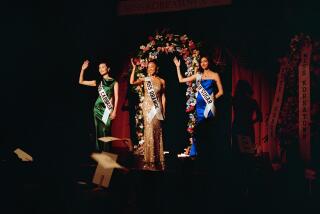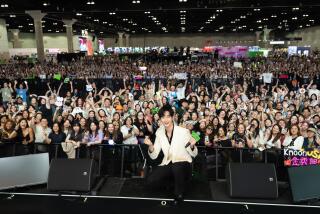DANCE REVIEW : Korea Festival Spins a Tale of Traditions
The Asia Society’s yearlong Festival of Korea opened its U.S. tour Wednesday with a program at UCLA’s Royce Hall that celebrated the survival of endangered traditions.
The two companies sharing the evening really didn’t belong together--or, for that matter, on a proscenium stage. But the institution that is now the Korean Traditional Performing Arts Centre had been decimated during the Japanese occupation of Korea and that ordeal gave it something in common with the Eunyul Masked Dance-Drama, which suffered near-extinction during the Korean War.
The half of the program devoted to classical performances (or chongak ) by the Korean Traditional Performing Arts Centre included two group dances, a solo by Eung-Seo Kim playing a large bamboo flute, a vocal duet by Dong-Kyu Lee and Jun-Ah Lee, plus a 7th-Century orchestral anthem enlisting 13 instruments.
Refined artistry remained consistent, with the throbbing resonance of Korean music kept subordinate to the elemental components of the ensemble. No gongs sound more metallic than Korea’s, no wooden flutes more woody, no voices more throaty. Rather than blending, these sounds and others stayed bright, parallel strands--with the dances adding another dimension of splendor.
Once a fixture of court banquets, the lyrical “Kainjonmokdan” dance found eight women repeatedly rising and sinking as if in liquid space, their long sleeves swirled in the air like streamers. Stalks of peonies further ornamented their flow through symmetrical groupings.
The sole masked dance of the court idiom, the stately “Ch’oyongmu” featured five identically ruddy, mustached faces, but costume colors and spatial gambits symbolized the east, west, north, south and center of the universe.
Originally performed outdoors at village festivals, the earthy and sometimes outrageous Eunyul masked-dance drama (or talch’um ) managed to ridicule the abuses of religious authority while reinforcing religion itself. The selection of episodes began with a wild exorcism dance for a moon-faced, six-legged lion and ended with a bravura solo for a shaman (Nam-Hee Kim) attempting to placate the spirit of a murdered wife.
Between these rites came dance-satires of dissolute monks, brain-dead noblemen and a philandering husband: the sacred, secular and domestic oppressors of three centuries ago, when talch’um evolved. For spice, add a copulation dance between a woman and a monkey, a birth scene, a penis inspection and the antics of the servant Malttugi (Young-Jin Kho)--always sharper than his masters but not so sensationally ugly in the Eunyul version as he is in other village’s depictions.
The distinctive vibrating tones of its music and the manipulation of sleeves linked Eunyul Talch’um to the court entertainments presented by the Korean Traditional Performing Arts Centre. However, nothing seen at court matched the magnificent bounding and hopping of the eight Eunyul monks in their revelry.
Swinging their arms, flinging their sleeves and jumping elastically in place while the drum, gong and reed ensemble sustained a cataclysmic blare, they transformed the graceful rising and sinking of traditional Korean dance into a glorious defiance of all physical and societal restraint.
More to Read
The biggest entertainment stories
Get our big stories about Hollywood, film, television, music, arts, culture and more right in your inbox as soon as they publish.
You may occasionally receive promotional content from the Los Angeles Times.










